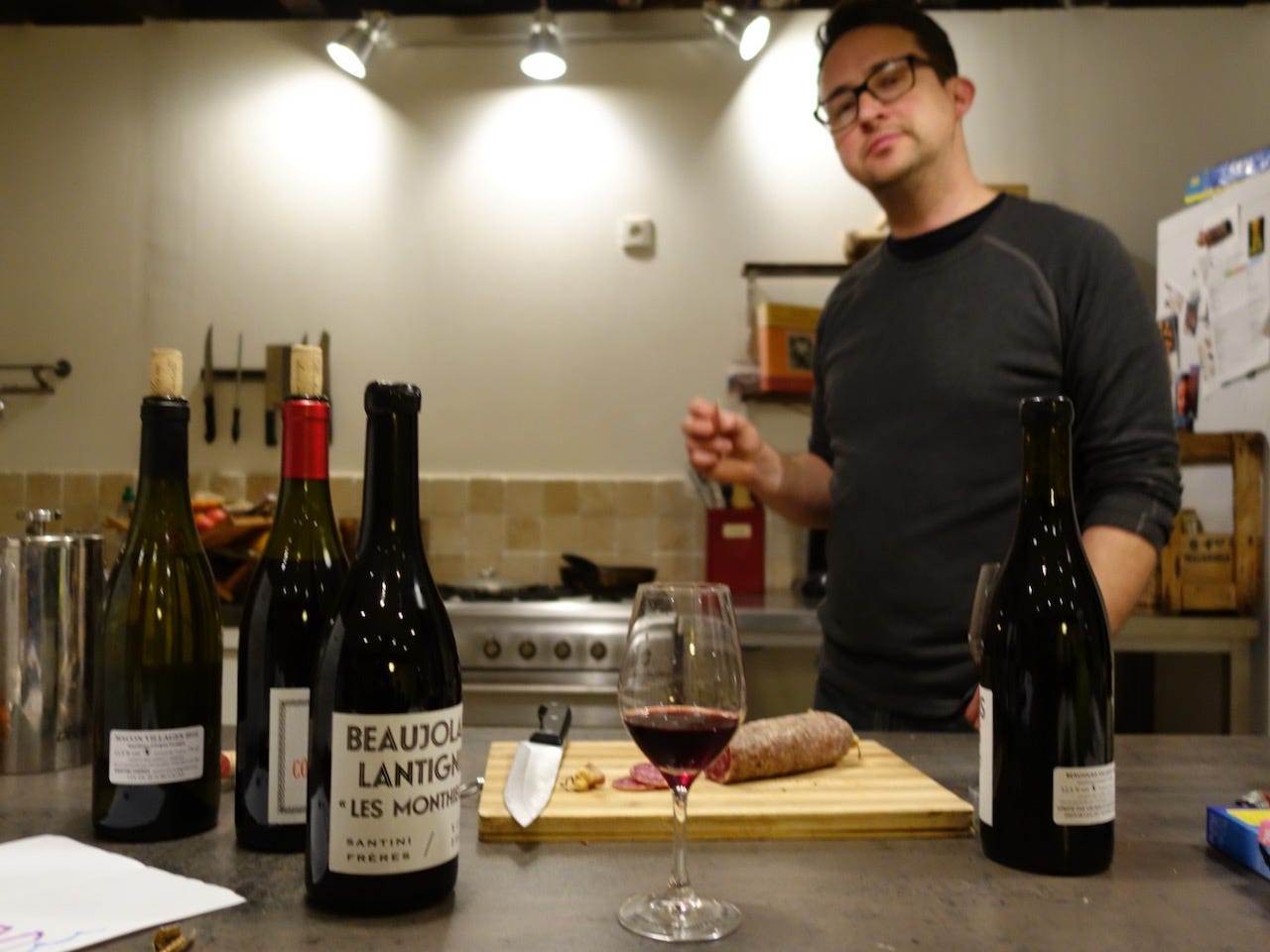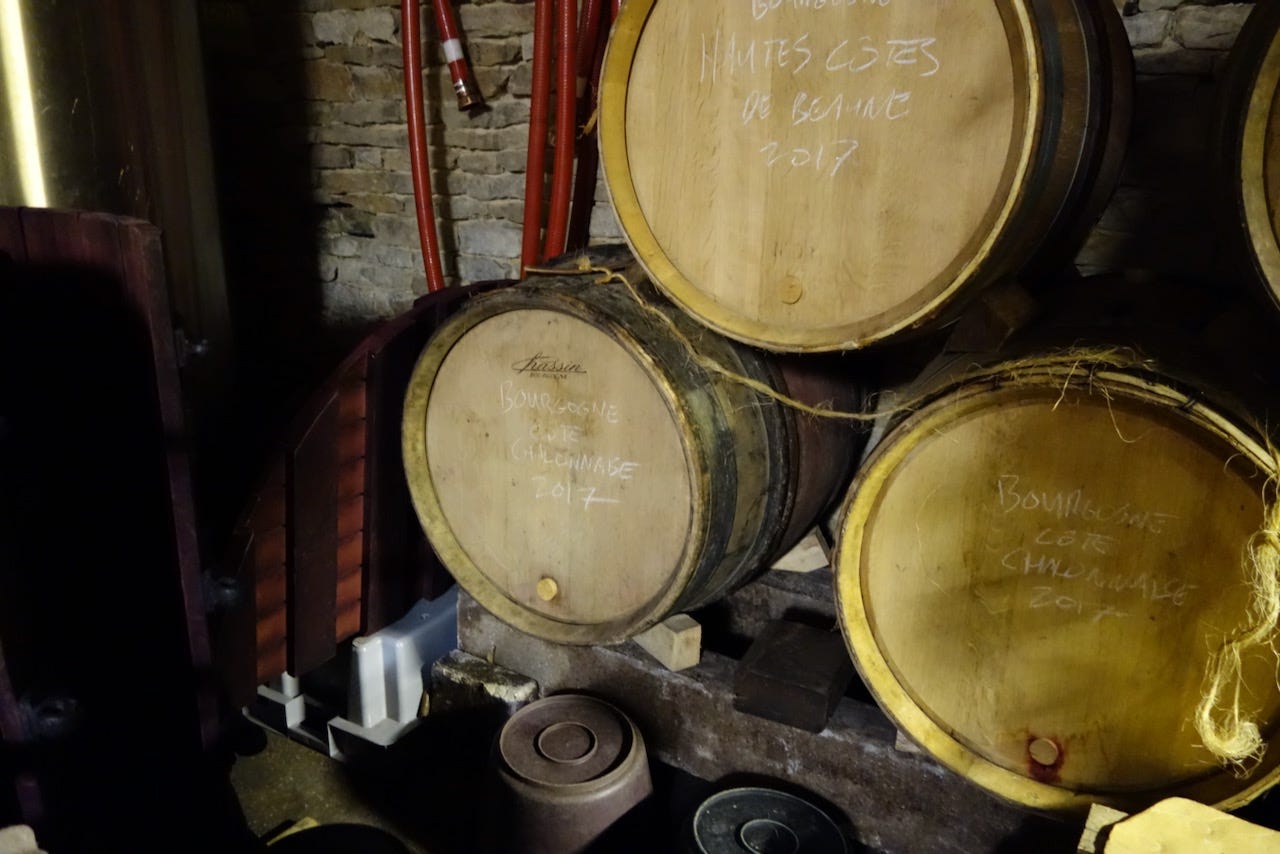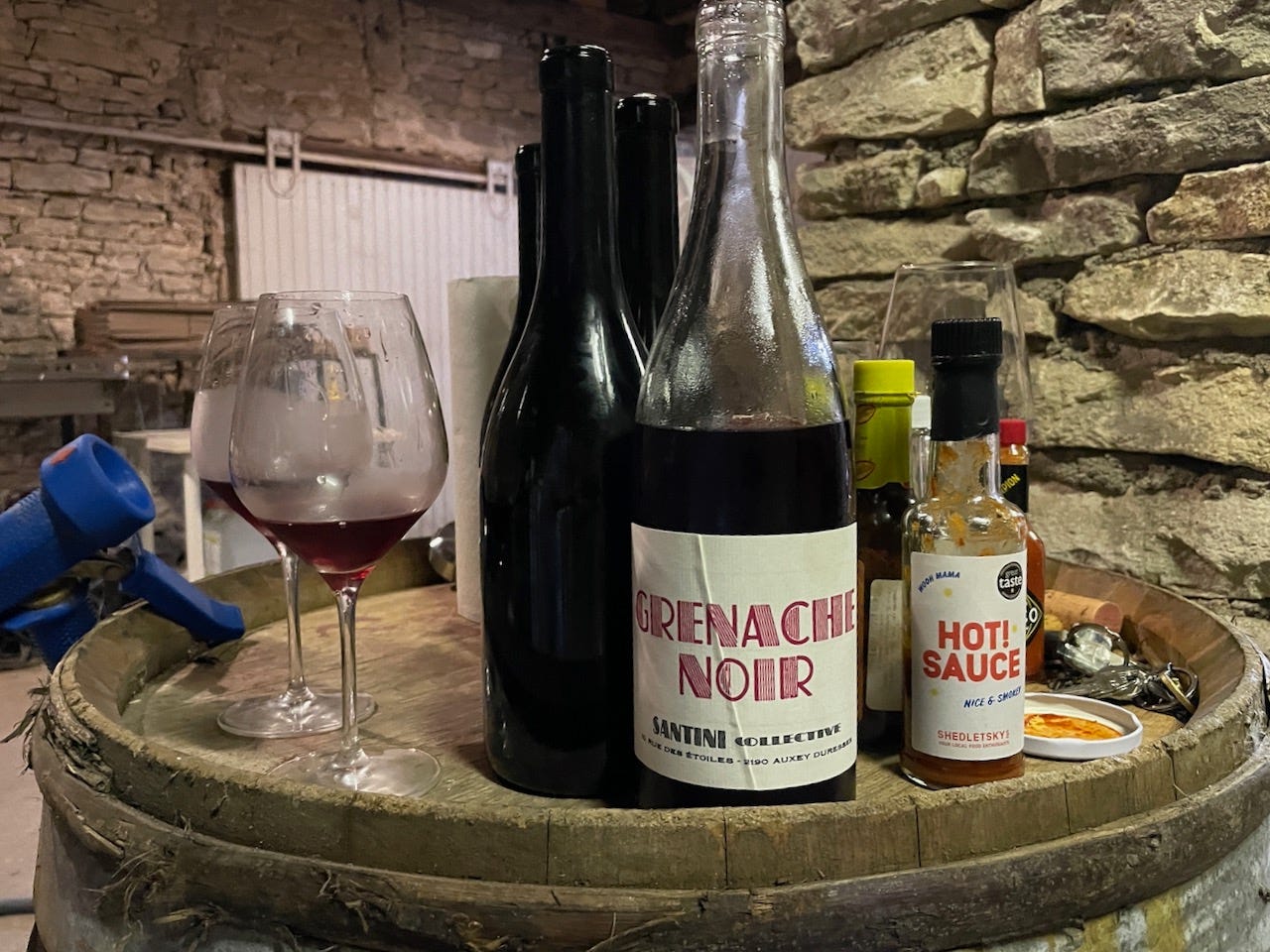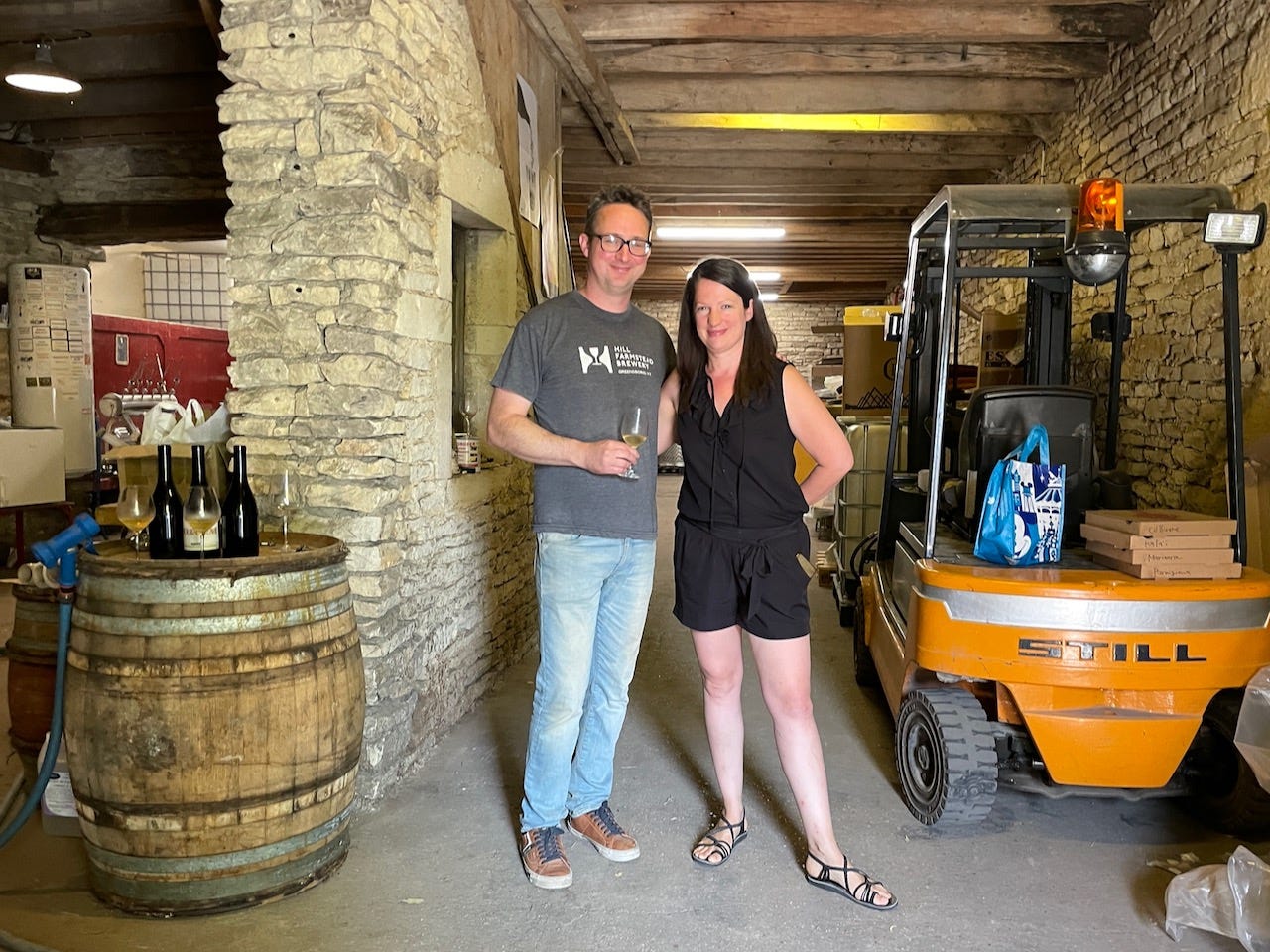The Saga of Santini
How négociant Chris Santini's shared cellar in Auxey nurtured a generation of natural winemakers in Burgundy - and nearly put him out of business.

Today’s thriving Burgundy natural wine underground owes a lot to small-scale natural wine négociant Chris Santini. Upon leasing cellar facilities in Auxey in 2016, Santini invited his friends Jon Purcell (of Vin Noé) and Christian Knott and Morgane Seuillot (of Domaine Dandelion) to join him in the space, providing these future-greats with a crucial leg-up. Later, hotly-tipped young négoçiants Bastien Wolber and Arnaud Lopez would also get their start in the space.
Santini initially sold his own wines under the label Santini Frères, before retitling the project Santini Collective. From the start, his aim was to make small-scale, affordable, easy-drinking wines from Burgundy and the Beaujolais. His wines sold well. But by 2019, his project had begun to founder financially, beset by an adversarial accountant from hell, alongside the reality that producing wine on a small-scale in Burgundy is, necessarily, somewhat costly.
I first met Santini through my late friend Josh Adler, who introduced us in 2013 or 2014. We’re friends - so it was with consternation that I noticed Santini’s absence from the wine scene throughout 2020 and 2021. Only when I called him to fact-check a few things for the last issue did I learn he’d been considering giving up winemaking. Instead, with the critical aid of a new, better accountant, and his Australian importer, Santini is starting a new chapter in 2022, one marked by a new press, longer fermentations, and a whole cellar (mostly) to himself.
Quick Facts
Originally from Pennsylvania, Chris Santini moved to Beaune in 2003 to pursue studies at the viticultural school, where he studied under professors like Jean-Yves Bizot and Sylvain Pataille. Friends and classmates there included Etienne Thiébaud, Catherine Riss, and Amaury Beaufort.
In 2006, Santini began working an an export assistant for the US importer Kermit Lynch, a job he maintains today on a part-time basis.
Santini began his career as a négociant in 2013, purchasing and reselling tiny lots of finished wines (from the likes of Guy Breton and Christophe Pacalet), before commencing vinification in 2015, in cellar space leased from Tomoko Kuriyama at Chantrèves.
He acquired his cellar in Auxey in 2016. It would become a critical incubator for expat natural winemaking talent in Burgundy, providing key support to the careers of Jon Purcell, Christian Knott, Bastien Wolber, Arnaud Lopez, and more.
Santini’s own wine range varies from year to year. Key cuvées include “Champlitte,” a blend of pinot and gamay from north of Dijon; a Beaujolais-Villages from Lantignié (produced in collaboration with Jon Purcell and, until the 2021 vintage, released under a shared label); an Hautes Côtes de Beaune rouge; and a Mâconnais white from Uchizy (released as Bourgogne Blanc in 2020). For a time in the 2010s, his reds were known for their old-school liter bottles.
Grapes sources are all organic. Wine are never fined or filtered. Santini has until now been in the habit of adding 1-2g /HL of sulfites before bottling.
Most of Santini’s reds have been vinified with carbonic maceration, until 2019, when he began experimenting with a Daniel Sage-inspired method of whole-clulster maceration immersed in direct-press juice (“flottaison,” to use Sage’s term). The results can be partially discerned in his non-vintage Vin de France Rouge (a blend of 2019 and 2021 juice) and a 2019 Vin de France grenache from the Drôme.
Santini made little wine in 2020 and 2021, as he debated whether to cease winemaking. But as of 2022 he’s back in action, preparing to relaunch Santini Collective in earnest, with a new vertical press and new grape sources.
THE SAGA OF SANTINI: A TIMELINE
This interview was conducted on June 17th, 2022. It has been condensed and edited for clarity.
2013-2014
CHRIS SANTINI: I started the business at my house in 2013. It was the classic negoce of buying finished wines. Usually I’d rent a van and go down with my liter bottles to Guy Breton’s place, or to Christophe Pacalet, and we’d pick a cuvée, and I’d bottle two- or three-hundred bottles
It was just to help me get started. To test out labels, waxing, logistics, and such, while I figured out the next steps. It was two-hundred bottles in 2013. In 2014, I did one-thousand.
2015
In 2015, I was at Tomoko Kuriyama’s cellar. She’s great - definitely a businesswoman, too.
I bought grapes that year. I did gamay from the Mâconnais, I got some pinot from the Couchois, and then some Beaujolais, and I wound up blending them together. It was called “Ponts Rouges.” I declassified it to Côteaux Bourguignons. Then I bought some Hautes Côtes de Beaune from Monbatois, which is that hill just above Savigny, and I bottled that in liter bottles.
2015 was a really easy vintage. The yeasts that year were wonderful. The fermentations were super clean. I was like, “Oh, this is so easy, this is great.” I’m glad I didn’t just go off on my own thinking like that. Because 2016 and 2017 were much more difficult.
2016
I got the keys to the cellar in Auxey in January 2016. The vigneron who had it before was vinifying 9ha. He had lots of concrete tanks, lots of stainless tanks. I was like, “Wow, it’s huge.”
I was ready to try making five- or six-thousand bottles, but not twenty- or thirty- or forty-thousand bottles. Jon [Purcell] at that point, he’d been working for David Croix for several years, and I knew he wanted to move on. And Christian and Morgane [of Domaine Dandelion] had gotten their vines, but they still didn’t know where they were going to vinify.
So to me it was kind of obvious. Why don’t we just do it here? I’ve got plenty of room. It wasn’t like I was making a sacrifice, because I felt I’d get as much or more out of the experience as they would. I didn’t feel like I was doing them a favor.
So in 2016 everybody vinified in here. It was super fun.
One night in August, just before harvest, we opened a bunch of Lapierre jeroboams that I’d bought, and we sprayed the walls as we drank. We were drinking and spitting Morgon. I’d heard you wanted to get some good yeast and bacteria going in a new cellar. For me the Lapierre wines have always been such an inspiration. So if ever those things do rub off somehow on the cuverie, I’d want it to come from their wine.
2017
It 2016 there was still plenty of space. So we all decided to pick it up a notch in 2017. And that was a really tough year.
It was the year I understood the complications of carbonic maceration. It’s great as long as things are going well, but things can easily go downhill, and after a certain point, it’s tough to manage, specifically with regards to volatile acidity.
And fermentations were not finishing. Those last few grams of sugar. For everything. It was in [Jon’s] Julienas, it was in the Beaujolais. We made some Beaujolais Nouveau that year, and it was the same thing. We were supposed to pour it at Noble Rot in London, and it finished fermenting like a week before Beaujolais Bouveau day. We bottled it and drove it up in a panic. It was super volatile, but it went over fine.
The experience had me scratching my head, and thinking this might not be as easy as I thought. Christian [Knott] really helped. He’s a freaking genius. I think he has the best approach, and the best way of seeing things and doing things. He can do something in thirty minutes that would take someone else half a day.
Jon was really good too. The things he does are super precise - anything from stacking barrels, to racking, to cleaning a tank. It’s brilliant, every time.
2018
2018 went pretty smooth. We’d gotten big enough that year that I needed help. A young couple from Vermont, Jessie and Jessica Grim, came for the whole harvest.
Jon [Purcell] did a lot of wine that year. Everybody was bumping up production. It was the first year it was really busy in here. I did 15,000 bottles.
2018 was the first vintage I had to allocate, instead of having to find new clients. It was nice to figure that stuff out. But at the same time, due to a combination of things - me being naive, and not calculating things properly, not charging the right prices - it was heading towards a brick wall.
2019
I had a meeting with the accountant right before the 2019 vintage, in June, and they were like, “You made 8000€ profit this year.”
I told them didn’t make 8000€ profit this year.
And they’re like, “No no no, because we took your inventory, and the value of your stock…” Of course, they were including Domaine Dandelion, and Jon Purcell’s stuff as well. I explained that I needed to give that money back, and they were like, “Well, the government doesn’t care.” I ended up getting hit with a lot of tax bills.
So before harvest, I said to myself, okay, I’m going to make 2019 my last vintage. There’s loads of grapes out there, I’ll make a lot of wine, and then I’ll use that money to pay off all my debts. The financial thing wasn’t working, and I owed tons of money left and right. It was just super demoralizing, after all those years, all those efforts.
Everybody in the cellar was super cool about it. Nobody at any point wanted anybody to shoulder any burden for anyone else. It was such a dark financial web, and none of us knew anything about accounting. We made so many stupid mistakes.
At first, I thought I’d do the accounting myself. I thought, how hard can it be? I thought I’d buy a book, and learn. But having an accountant is so important. And having a good accountant is so important.
Because I had a terrible accountant. The situation was so confusing, so instead of trying to help me, they were just trying to save their own ass. They were afraid I was doing something wrong, so there would be a check-up on them.
Thankfully, when Jon [Purcell] started his company, he found a really good accountant, who really understood it. Now Jon, Bastien [Wolber], and I all have the same accountant.
Every expat has had to go through this. Every little small estate or micro negociant. I think, at first, we all went through it alone, thinking, “Oh my god, I must be doing something wrong.” Now we realize everyone goes through it. And it’s good, because we all help each other out and give each other tips and stuff.
2020
So I made a big crop of 2019s. I was really happy with the wines, and there was huge demand. I did my calculations, and on paper everything was great. I figured I might be able to break even.
And I think I’m done. I wanted to stop those sleepless nights of thinking, “Oh my god, what am I going to do, are they going to take my house?” It was terrible. I wanted to get rid of that stress.
I told the accountant, “I’m going to sell all my stock, and I want my company done by December 31st.” And he looked at me like I was crazy. He said, “You can’t do that.” I said, “What you do mean I can’t do that?”
He said, if you sell all your stock this year, you’re going to get hit with like a 50,000€ bill from URSSAF, because you’ll have all your income from two years in one year. And not only that, but it could look suspicious to the fiscal services, that you’re closing a company that is successful on paper, and it could trigger an audit…
Plus, COVID had arrived, and all the people who had loaned me money were asking for it back. And there were no orders now, because everybody had put everything on hold. So with whatever cash I could find, I was just paying people back. So I had to sell the 2019s over two years, and I felt bad about shutting the cellar down, because Dandelion didn’t have a cellar yet, and Jon didn’t have a cellar yet. And then Bastien [Wolber] was looking for a place, and Arnaud Lopez was looking for a place. So it was super busy. And Jon now had his own vineyards that were coming in. So I told everybody they could make as much 2020 as they want.
I planned to sell off half my stock in January 2021, and then shut the company down in February 2021. I made some gamay from Auxey-Duresses in 2020, and some Bourgogne Blanc. We didn’t do Lantignié in 2020. The cellar was already too full, and too busy, and I didn’t want to find myself with too much wine if i was going to shut down in February 2021.
2021
After 2020, it was either I shut it all down, or I figure something else out. But I couldn’t get myself to pull the trigger. So 2021 was the year of indecision.
On the one hand, I’d done all the things I wanted to accomplish. Having my family in the US drink the wine, and having restaurants I admire pouring the wines. But at the same time, the project was really just beginning. I really wanted to develop the flottaison vinification, but I couldn’t, because I didn’t have the right press.
Since there was no grapes around, and prices were through the roof, I figured I’d leave the 2021 grape purchases to people who really needed them. So I only made 2000 bottles [of a blend of Beaujolais-Villages from 2021 and 2019 “Champlitte,” released as Vin de France].
Then, before the 2021 harvest, everybody moved out and got their own cellar. And as the place emptied out, and got less crazy and less hectic, I kind of reconnected with the way it was when I first moved in here. So I said, well, why don’t I figure out a way to make it work.
2022
What I’m going to do is make less wine. Obviously I’ll have to charge more for it. I’ll invite a few people in, but I’ll keep it small. If someone needs to make four or five barrels, great - but no more. I’m going to try to keep it more manageable. I think it should be good.
I’ll do Beaujolais-Lantignié with Jon again, although we won’t vinify it together, we’ll split the grapes. I’ll do Bourgogne Blanc, or Mâcon, depending on what the grower has. A pinot from the Côte Chalonnaise. And “Champlitte.” I’m hoping to get some pinot beurot. And I’m definitely open to other sources. I kinda stayed on the sidelines, these last few years, so I’m a little out of the loop.
If I were to do it all over again, the one thing I would not change is having Jon and Dandelion in here during those early years. Because it was fun, and it was super educational. It was just the right mix of people.
FIN
Santini Collective
10, rue des Etoiles
21190 AUXEY-DURESSES
FURTHER READING
Domaine Dandelion Branches Out
From San Diego to Saint Aubin: Vin Noé
Onwards and Upwards at Laisse Tomber















Legend !